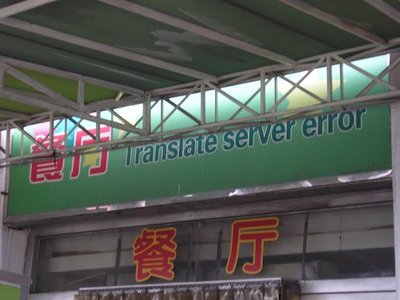While I’ve been traveling over the last week or so, loads of people sent me a link to this wonderful image of a sign in China reading “Translate Server Error” which has been written up all over the place. Thanks everyone!

It’s pretty easy to imagine the chain of events to led to this revealing error. The sign is describing a restaurant (the Chinese text, 餐厅, means “dining hall”). In the process of making the sign, the producers tried to translate Chinese text into English with a machine translation system. The translation software did not work and produced the error message, “Translation Server Error.” Unfortunately, because the software’s user didn’t know English, they thought that the error message was the translation and the error text went onto the sign.
This class of error is extremely widespread. When users employ machine translations systems, it’s because they want to communicate to people with whom they do not have a language in common. What that means is that the users of these systems are often in no position to understand the output (or input, depending on which way the translation is going) of such systems and have to trust the translation technology and its designers to get things right.
Here’s another one of my favorite examples that shows a Chinese menu selling stir-fried Wikipedia.

It’s not entirely clear how this error came about but it seems likely that someone did a search for the Chinese word for a type of edible fungus and its translation into English. The most relevant and accurate page very well might have been an article on the fungus on Wikipedia. Unfamiliar with Wikipedia, the user then confused the name of the article with the name of the website. There have been several distinct citings of “wikipedia” on Chinese menus.
There are a few errors revealed in these examples. Of course, there are errors in the use of language and the broken translation server itself. Machine translations tools are powerful intermediaries that determine (often with very little accountability) the content of one’s messages. The authors of the translation software might design their tool to avoid certain terminology and word choices over others or to silently censor certain messages. When the software is generating reasonable sounding translations, the authors and readers of machine translated texts are usually unaware of the ways in which messages are being changed. By revealing the presence of a translation system or process, this power is hinted at.
Of course, one might be able to recognize a machine translation system simply by the roughness and nature of a translation. In this particular case, the server itself came explicitly into view; it was mentioned by name! In that sense, the most serious failure was not that the translation server worked or that Wikipedia was used incorrectly, but rather that each system failed to communicate the basic fact that there was an error in the first place.